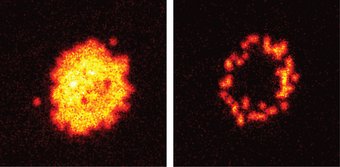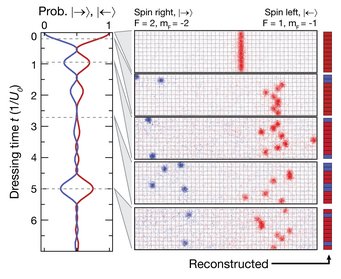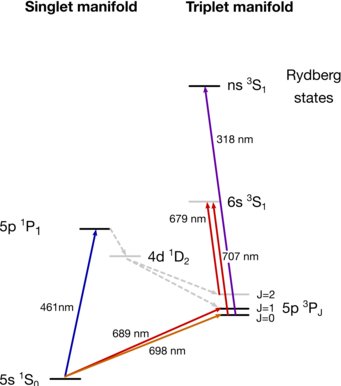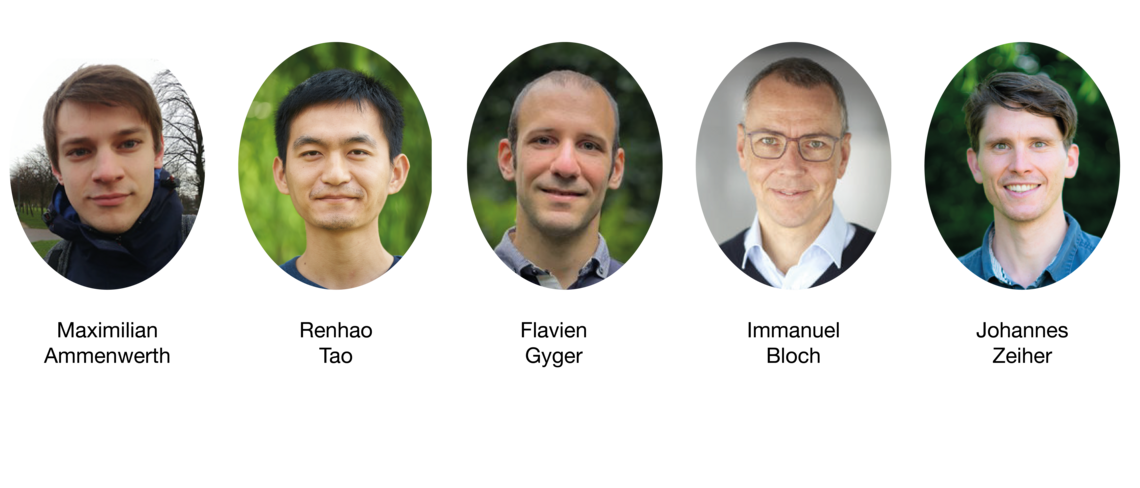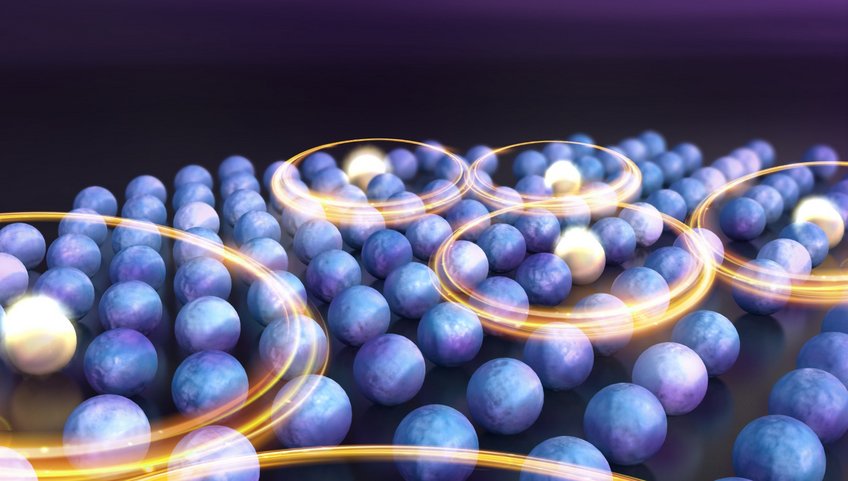
Strontium Rydberg Lab
Analog and digital quantum simulation and quantum computing with Rydberg atoms
Long-range interacting neutral-atom arrays are versatile platforms for analog or digital quantum simulation and quantum computation. Recent breakthroughs in the control of single atoms trapped in optical lattices and optical tweezers have started to show the potential of a bottom-up assembly of quantum matter atom-by-atom, and controlling all relevant degrees of freedom. The goal of our Strontium Rydberg experiment is to combine the large-scale clean neutral-atom arrays that can be realized in optical lattices with local control and versalitily featured by optical tweezer arrays. Interactions between the atoms will be induced by coupling to Rydberg states on or off-resonantly, which provides a flexible toolbox for simulating many-body systems reaching from Ising spin models to itinerant extended Hubbard systems.
Rydberg Atoms in Optical Lattices
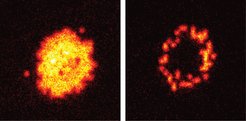
One central ingredient to the physics we aim to explore are highly excited atomic states, so-called Rydberg states. These highly excited atomic states have energies close to the ionization threshold in an atom, and the electron is only loosely bound to the atomic core. In consequence, atoms excited to Rydberg states have orders of magnitude larger interactions than atoms in the ground states. Arising from electrostatic interactions of two neutral atoms, Rydberg interactions are typically of van-der-Waals character. Controlling these interactions is possible by finely tuned laser coupling from the ground to the Rydberg states, which can routinely be achieved in our labs. The accurate control over Rydberg interactions allows us to realize various spin models in cold atomic gases. In previous experiments, we explored the Rydberg toolbox in several experiments. The picture to the left shows an exemplary image of an atomic array coupled off-resonantly to Rydberg states. This so-called "Rydberg dressing" allows for optically admixing the Rydberg ineraction to the ground state atoms, which endows the ground state with long-range interactions. In our experiment, we detect this admixture as the appearance of a ring-like structure appearing after some time.
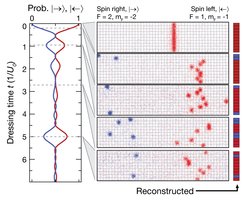
The long achievable coherence times can also be measured in our experiments. The images on the left show a quantum quench experiment, where an intitial out-of-equilibrium state is prepared at the beginning. Subsequently, the parameters of the Hamiltonian are rapidly altered, which leads to characteristic dynamics. The resulting revivals of the magnetization signal the coherence of the system, which allows for simulating quantum dynamics with single-atom control and spin detection in optical lattices.
In our new experiments, we plan to leverage many of these techniques and complement them with new developments described below. In particular, we aim at larger two-dimensional systems while maintaining single-atom sensitive detection and local resolution, higher coupling rates to Rydberg states and hence even longer coherence times, and enhanced control capabilities to locally address the atoms in our optical lattice arrays. These developments will open many new avenues, including the implementation of novel spin models with time-dependent interactions, the realization of lattice gauge theories and the study of itinerant long-range interacting gases. One advantage of Rydberg-based interactions is their switchability, which also allows for hybrid analog/digital quantum simulation and digital quantum computations.
Strontium
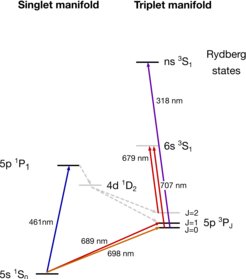
We choose the alkaline-earth atom strontium for our experiment. Strontium features an electronic structure with a triplet and a singlet series. Optical transitions from the singlet to the triplet series are spin forbidden, which implies that they are very weak and the excited states are very long lived. One famous example for such a weak transition is the clock transition from a singlet S state to a triplet P state (1S0 to 3P0) at 698nm. This transition forms the basis of the world's most accurate atomic clocks. The excited clock state 3P0 is an ideal starting state for strong coupling to the Rydberg manifold, which allows for realizing highly coherent many-body dynamics. The long achieved coherence times on the clock transition together with the fast coherent Rydberg coupling make strontium also a prime candidate for Rydberg-based quantum computing applications. A particularly intriguing direction would be to combine the features of Rydberg interacting many-body systems with the optical clock properties: One way in which this could be envisioned is via the creation of entangled states, which has been shown theoretically to lead to improved optical clock performance. This "Rydberg-enhanced" metrology is an alternative pathway uniquely tailored to strontium atoms.
Sortable Optical Lattices
For all applications described above, atoms were trapped in laser beams far detuned from any optical transitions. Optical lattices are formed by retroreflected laser beams, which creates a standing wave intensity pattern, with a spacing determined precisely by the wavelength. Two-dimensional lattices provide a clean implementation of a regular array of optical traps, with minimal disorder in the depth of the traps. Complementarily, individually focussed laser beams, so-called optical tweezers, provide the required toolbox to spatially address atoms as well as grab and move atoms from one trap to another. To leverage the full potential of Rydberg quantum simulators, we aim at combining these two technologies: For our experiments, the atoms will be trapped in the clean potential landscape offered by optical lattices, and the local position and state control will be added by optical tweezers. This will allow for versatile control over the initial atomic configuration, and provide a new control-knob for lattice-trapped neutral atoms coupled to Rydberg states.
The Team
Maximilian did his Master at the University of Bonn where he was working with small atomic ensembles trapped inside a high-finesse fiber cavity. In 2021 he joined the Strontium Rydberg Lab as a PhD student.
Flavien did his PhD at EPFL in Switzerland and recently joined the Strontium Rydberg Lab as a postdoc. His PhD research has been focused on the study of stimulated Brillouin scattering in various waveguides, including silicon nitride photonic chips and gas-filled hollow-core fibres. He now aims at shifting his research field towards more fundamental atomic physics by studying many-body quantum entanglement between cold atoms in optical lattices. He is particularly attracted by the ambitious goal of reconciling classical and quantum physics via a clearer understanding of the concepts of decoherence and wavefunction collapse. To relax after work, he usually enjoys diverse outdoor activities such as cycling and playing tennis.
Renhao did his undergraduate work at UCSB and worked in Pennathur lab on developing a nanofluidic sensor for real-time DNA detection. Later, he moved to Munich and built a box trap to study photo-induced collisional losses of ultra-cold molecules. He joined the Strontium Rydberg Lab in late 2020 as a PhD student to construct a hybrid quantum computer. If not in the lab, he is typically on some hiking trail deep in the Alps.
Johannes is all excited about Rydberg atoms and their application in quantum simulation and quantum computation. In his PhD, he explored Rydberg-coupled lattice-trapped atomic gases in MPQ. For his postdoc, he explored photon-induced long-range interactions and non-destructive detection enabled by high-cooperativity optical cavities in the group of Prof. Stamper-Kurn in Berkeley. In his free time, Johannes enjoys running and cycling in and around Munich, especially in the mountains.
Interested? Join us!
We are always looking for motivated students (working student, Bachelor, Master), PhD candidates and Postdocs to help us with our experiment. Reach out to us if you are interested in joining our team!
